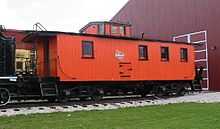Cupola
In architecture, a cupola /ˈkjuːpələ/ is a small, most often dome-like, structure on top of a building.[1] Often used to provide a lookout or to admit light and air, it usually crowns a larger roof or dome.[2][3]
The word derives, via Italian, from the lower Latin cupula (classical Latin cupella from the Greek κύπελλον kupellon) "small cup" (Latin cupa) indicating a vault resembling an upside down cup.[4]
-
Cupolas on the towers of Montefiascone Cathedral, Italy.
-

Ribbed cupola crowns the minaret of the Mosque of Uqba, in Kairouan, Tunisia.
-

Cupolas were also used on some old barns for ventilation.
-

A cupola-style caboose with an angel seat above
The cupola is a development during the Renaissance of the oculus, an ancient device found in Roman architecture, but being weatherproof was superior for the wetter climates of northern Europe. The chhatri, seen in Indian architecture, fits the definition of a cupola when it is used atop a larger structure.
Cupolas often appear as small buildings in their own right. They often serve as a belfry, belvedere, or roof lantern above a main roof. In other cases they may crown a spire, tower, or turret. [3] Barns often have cupolas for ventilation.
The square, dome-like segment of a North American railroad train caboose is also called a cupola.
Some armored fighting vehicles have cupolas in the form of a raised dome or cylinder with armored glass to provide 360-degree vision around the vehicle.
See also
References
| Wikimedia Commons has media related to Cupolas. |
- ↑ "Glossary of Architectural Terms - C". Archiseek: Online Architecture Resources. Retrieved 3 January 2009.
- ↑ "cupola". The American Heritage Dictionary of the English Language, Fifth Edition. Houghton Mifflin Harcourt Publishing Company. 2014. Retrieved 26 April 2015.
- ↑ 3.0 3.1 "Just what is a cupola anyway?". Cupola Consulting. Retrieved 3 January 2009.
- ↑ In Italian cupola simply means dome, and the ornamental top element is called lanterna.


